Background
In Andhra Pradesh (A.P.), a combination of proven and new strategies was set in motion to tackle the COVID-19 outbreak. Driven by political commitment and seamless coordination amongst officials and partners, the state government used measures including early screenings, vigilant surveillance, tracing, testing and isolating, digital interventions and strengthening the healthcare system. It kept the outbreak in check by establishing district-level control rooms for monitoring the on-ground situation, equipping frontline health workers with the tools they needed, while engaging with communities, addressing people’s psychosocial needs and guaranteeing the delivery of essential health services in this crisis.
A.P. which has a population of 53 million, reported its first COVID-19 case in March. One of the early states to invoke the Indian Epidemic Diseases Act (1987), A.P. has documented 6,87,351 cases as of September 29, 2020. Despite the rising numbers, it has maintained a Case Fatality Rate of 0.84, one of the lowest in the country. In terms of testing, the southern Indian state has conducted over 1,00,000 tests per million people, the highest amongst large states in the country.
By combining novel approaches as well as best practices from disaster management planning, the A.P. government ensured that responses were designed in collaboration with partners and deployed in time with adequate resources.
Exemplary political commitment, inter-sectoral synergy and partner support ensured a well-rounded response
A high-level committee led by the Chief Minister, Health Minister, Chief Secretary and Special Chief Secretary (Health) was constituted to monitor, coordinate and guide actions on the field. Under the direction of the Principal Secretary, Mission Director of National Health Mission, Commissioner Health & Family Welfare and other officers, members of the State Control Room and sub-committees kept a close watch on the situation. In districts, the District Collectors and District Magistrates led and steered the committees and task forces which were set up specifically for COVID-19 containment. Representatives from relevant state departments joined hands, thereby synergizing efforts. A key intervention was the effective deployment of village/ward secretariats for cluster management, as well as for survey and supply of essential commodities in containment zones. Thus, the state and district leadership took ownership of the response and reviewed aspects of every programme regularly. These reviews focused on progress of all relevant health programmes.
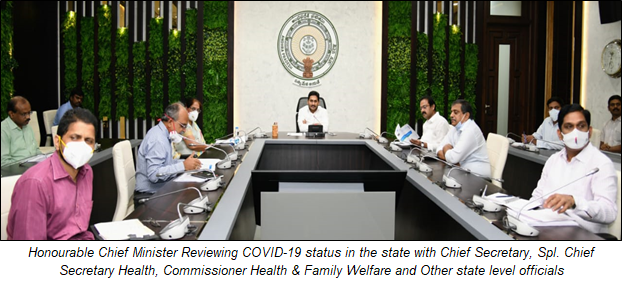
Officials and workers identified contacts, tested them, assessed fever clinics in containment zones and supervised hospital preparedness to maintain quality of care. At least 80 Instant COVID Orders were issued by the Health Medical and Family Welfare Department, which served as guidance notes on various aspects of COVID-19 control and containment for state and district representatives. The World Health Organisation (WHO) was onboarded to provide technical counsel on COVID--19 response - especially on testing, contact tracing, containment planning, isolation and treatment. The early guidance shared by WHO during start of the pandemic laid the foundation for a stronger and cohesive response. In mid-April, the team facilitated discussions and resumed essential services, supporting routine immunization and improving coverage, non-communicable diseases and for improving surveillance around vaccine preventable diseases.
"The response to COVID-19 pandemic in A.P. was guided by sound scientific principles. We identified the cases early through community-based surveys and targeted testing, followed by early isolation and treatment in designated COVID-19 hospitals. The follow up contact tracing and containment activities through large cadre of field workers and use of technology helped in containing the spread. WHO has been a strong partner of A.P. in several health programmes for over two decades. With regard to COVID-19, we appreciate the team’s support to the State in ensuring an effective response." - Sri Bhaskar Katamneni, IAS, Commissioner, Health & Family Welfare
"The health systems in Andhra Pradesh responded to the challenges of the pandemic by focusing on testing, tracing and, isolation. This helped in detecting cases early, thereby preventing the further spread of the virus. Strong leadership at all levels coupled with regular review of the response as well a ‘whole-of-society’ approach strengthened the fight against this pandemic. We value our long-standing partnership with Government of Andhra Pradesh and would continue to support the response and other mitigation measures through our teams on the ground."- Dr Roderico H Ofrin, WHO Representative to India
Early trainings and screening were game changers
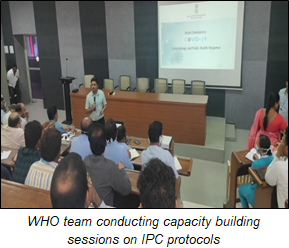 In March 2020 early trainings that were held under the expert supervision of state leaders like the Special Chief Secretary (Health) and the Mission Director-National Health Mission, equipped the members of District Rapid Response Teams and state medical colleges on aspects such as attending to COVID-19 patients in quarantine centres, which were then cascaded to ultimately build the capacity of frontline workers. WHO officials combined forces in capacity building by training Medical Officers of primary health centres (PHCs) to identify and monitor those demonstrating influenza-like illness (ILI) and severe acute respiratory infections (SARI). The government also organised mock drills on containment and community surveillance and held trainings on Infection Prevention and Control (IPC) protocols in hospitals across the state. Early screening of incoming passengers at all airports and seaports helped monitor those travelling into and out of the state. When cases started rising in the country, officials also screened incoming passengers from other states at inter-state bus and train terminals.
In March 2020 early trainings that were held under the expert supervision of state leaders like the Special Chief Secretary (Health) and the Mission Director-National Health Mission, equipped the members of District Rapid Response Teams and state medical colleges on aspects such as attending to COVID-19 patients in quarantine centres, which were then cascaded to ultimately build the capacity of frontline workers. WHO officials combined forces in capacity building by training Medical Officers of primary health centres (PHCs) to identify and monitor those demonstrating influenza-like illness (ILI) and severe acute respiratory infections (SARI). The government also organised mock drills on containment and community surveillance and held trainings on Infection Prevention and Control (IPC) protocols in hospitals across the state. Early screening of incoming passengers at all airports and seaports helped monitor those travelling into and out of the state. When cases started rising in the country, officials also screened incoming passengers from other states at inter-state bus and train terminals.
Strong surveillance contained the spread
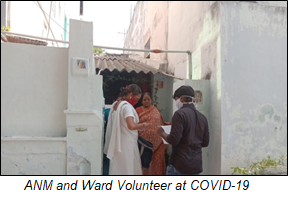
A.P. stands as the only state that has conducted five rounds of the COVID-19 household surveys, the aim of which was to collect the health particulars of every family member in a household. Specifically,
- The first survey aimed to identify travellers from overseas, quarantine them and test the symptomatic ones.
- The second one aimed to monitor returning migrants from other states.
- The third, fourth and fifth surveys looked at identifying ILI/SARI cases and mapping high-risk populations.
Teams of ASHA workers and volunteers from wards/villages led these surveys, visiting households and keying in information on symptomatic cases into the Matha Shishu Samrakshana (MSS) application. Medical Officers then visited families and collected samples for testing. At least 15 million households were visited/interviewed through the survey and 0.85 million ILI cases were identified and tested in the fifth round of survey. Apart from this, the WHO team supported the sero prevalence survey to assess the prevalence of the disease and ensured meticulous data collection through specialized systems and portals. The team’s efforts in sustaining routine immunization and surveillance of other viral infections such as measles and rubella have been equally critical.
Adopting the strategy of tracing, testing and isolating was effective
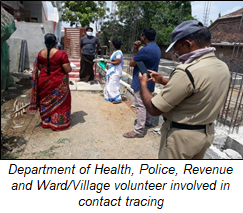
The state government undertook WHO’s strategy of tracing, testing and isolating as many citizens as possible, with vigour. It ramped up testing capacity to enable 1100-1300 samples per million to be tested every day. At the end of March 2020, the state had only four functional labs which had RT-PCR tests. Presently, at least 121 government and five private labs in the state have the capacity to test for COVID-19 through RT-PCR/TrueNat/CBNAAT machines. Rapid Antigen Tests (RATs) were conducted by supplying RAT kits at different rural and urban primary health centres such as the Mukhyamanthri Aarogya Kendrams.
As part of the sentinel surveillance strategy, which divides population groups according to their exposure to risk, officials collected samples from high-risk groups from across 13 districts to check the prevalence of COVID-19 in the select communities. To make sample collection easier, the state introduced intelligent monitoring analysis service quarantine (iMASQ) buses, which serve as mobile testing units, especially to cover high-risk areas. A.P. is also one of the first states to introduce bi-directional tests for screening all diagnosed patients of TB. As on September 2020, A.P. had tested at least 15,000 TB patients for COVID-19 and 6,000 COVID-19 patients for TB. Presently overall testing rates have increased significantly in the state - as of 30 September 2020, 1 07 392 tests per million are done in A.P.
Using digital capacity for containment was an innovative and efficient step
 Health programmes rapidly adopted digital technology to strengthen their data management. Mobile-based applications (apps) were developed and used for real-time reporting and monitoring cases. Key examples are the Matru Sisu Samrakhshana(MSS) app to improve maternal and child health, the health vitals app, used by frontline workers for monitoring vital signs amongst quarantined/isolated patients and the contact tracing app which is used by various teams and health workers for verifying and building a database of primary and secondary contacts of patients. The Health, Medical and Family Welfare Department developed a dashboard to make patients’ status available online, especially to update families. The Chief Minister also launched the YSR Telemedicine facility which remains open for the public from 8 am to 6 pm on all days. Those suffering from symptoms of COVID-19 can access medical advice by dialling 14410. This service is being widely used and has drastically decreased the burden on hospital out-patient care.
Health programmes rapidly adopted digital technology to strengthen their data management. Mobile-based applications (apps) were developed and used for real-time reporting and monitoring cases. Key examples are the Matru Sisu Samrakhshana(MSS) app to improve maternal and child health, the health vitals app, used by frontline workers for monitoring vital signs amongst quarantined/isolated patients and the contact tracing app which is used by various teams and health workers for verifying and building a database of primary and secondary contacts of patients. The Health, Medical and Family Welfare Department developed a dashboard to make patients’ status available online, especially to update families. The Chief Minister also launched the YSR Telemedicine facility which remains open for the public from 8 am to 6 pm on all days. Those suffering from symptoms of COVID-19 can access medical advice by dialling 14410. This service is being widely used and has drastically decreased the burden on hospital out-patient care.
Boosting state health infrastructure
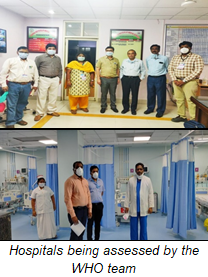 During the pandemic, the state government established dedicated COVID-19 hospitals at the state and district-levels, which were complemented by well-trained health teams. State and District Medical Boards were constituted to guide on treatment methods, discharge protocols and assess each positive case. To reduce patients’ out-of-pocket expenditure, COVID-19 was included in state-specific cashless health insurance schemes and prices were capped for all relevant procedures for those who were not covered by insurance plans. Private hospitals which are primarily enrolled under the YSR Arogya Shri Trust were also converted to dedicated COVID hospitals to manage surging cases. At least 500 Medical Officers were recruited at PHCs to support COVID and non-COVID operations on the ground. WHO officials joined efforts in ensuring quality care and adherence to protocols by assessing hospitals. They evaluated at least four state-level COVID hospitals (in Vijayawada, Prakasam, Nellore and Vishakhapatnam) and 11 district-level dedicated COVID facilities. To strengthen the referral mechanism for COVID and non-COVID patients the state also inducted new ambulances.
During the pandemic, the state government established dedicated COVID-19 hospitals at the state and district-levels, which were complemented by well-trained health teams. State and District Medical Boards were constituted to guide on treatment methods, discharge protocols and assess each positive case. To reduce patients’ out-of-pocket expenditure, COVID-19 was included in state-specific cashless health insurance schemes and prices were capped for all relevant procedures for those who were not covered by insurance plans. Private hospitals which are primarily enrolled under the YSR Arogya Shri Trust were also converted to dedicated COVID hospitals to manage surging cases. At least 500 Medical Officers were recruited at PHCs to support COVID and non-COVID operations on the ground. WHO officials joined efforts in ensuring quality care and adherence to protocols by assessing hospitals. They evaluated at least four state-level COVID hospitals (in Vijayawada, Prakasam, Nellore and Vishakhapatnam) and 11 district-level dedicated COVID facilities. To strengthen the referral mechanism for COVID and non-COVID patients the state also inducted new ambulances.
Engaging the community through innovative campaigns has raised awareness
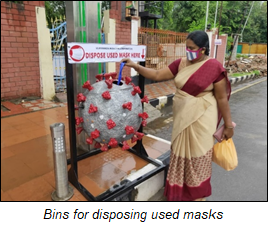 To raise awareness regarding COVID-19 appropriate behaviour, specifically on using and disposing of masks, the Deputy Chief Minister, Minister of Health & Family Welfare launched the Maskekavacham campaign on August 28, 2020. The campaign highlighted the value of physical distancing and cough etiquettes. As part of the initiative, the government installed handwashing stations and dustbins at strategic locations to instil an understanding of COVID appropriate practices and change behaviour. It set up waste collection units especially for disposing of used masks in strategic locations and to promote awareness regarding the disposal of biomedical waste. UNICEF and UNDP supplemented efforts on communications and in addressing stigma related to COVID-19 respectively.
To raise awareness regarding COVID-19 appropriate behaviour, specifically on using and disposing of masks, the Deputy Chief Minister, Minister of Health & Family Welfare launched the Maskekavacham campaign on August 28, 2020. The campaign highlighted the value of physical distancing and cough etiquettes. As part of the initiative, the government installed handwashing stations and dustbins at strategic locations to instil an understanding of COVID appropriate practices and change behaviour. It set up waste collection units especially for disposing of used masks in strategic locations and to promote awareness regarding the disposal of biomedical waste. UNICEF and UNDP supplemented efforts on communications and in addressing stigma related to COVID-19 respectively.
Ensuring uninterrupted delivery of non-COVID-19 essential services
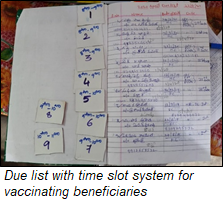 A.P. started routine immunization services from as early as April 14, 2020 following IPC protocols such as maintaining social distancing, ensuring separate time slots for beneficiaries, handwashing before vaccinating, etc. Further, the state government started universal screenings for non-communicable diseases (NCDs), communicable diseases (CDs) and anaemia. Going forward, the government aims to screen more than 5.3 crore people with the support of 20,000 ANMs and through house-to-house visits. The health status of the citizens will be uploaded on a dedicated web portal. Those with health risk conditions will be examined and treated by Medical Officers.
A.P. started routine immunization services from as early as April 14, 2020 following IPC protocols such as maintaining social distancing, ensuring separate time slots for beneficiaries, handwashing before vaccinating, etc. Further, the state government started universal screenings for non-communicable diseases (NCDs), communicable diseases (CDs) and anaemia. Going forward, the government aims to screen more than 5.3 crore people with the support of 20,000 ANMs and through house-to-house visits. The health status of the citizens will be uploaded on a dedicated web portal. Those with health risk conditions will be examined and treated by Medical Officers.
By combining proven methods, novel interventions, drawing from the inherent strength of the health system and the expertise of partners, state and district leadership have led the charge through this pandemic. Even as A.P. continues to fight the disease, it demonstrates the importance of synergising efforts and innovative thinking in controlling a crisis.
"We supported the Government in building capacity of the health cadres very early in the pandemic for surveillance and response. Besides, the WHO on ground team helped in assessing hospital preparedness, built capacity on infection prevention and control and supported districts in mounting a data driven response through collection of epidemiological data. We continue to support for the upcoming COVID-19 vaccination drive." - Dr Asish Satapathy, WHO Regional Team Leader South India
